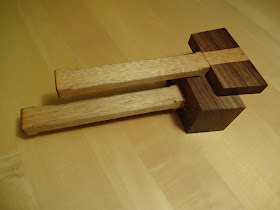 |
| Trevor the Mallet and Travis |
I noticed early on in my hobby, that when I finished a project, I often felt like next time I could do it better, faster, or with something different.
Usually, I wouldn't do it again.
This could be a mistake in some cases. I think that what is really going on is that my project was actually a prototype. Even better, you could call it the first prototype.
A good example in my recent work was with a recent project, the diagonal Chinese cross puzzle. The first one took me two days. The second one, which was arguably better, took two hours. I think I would even like to build a third, as perhaps I think I could improve the fit. Or at least try something.
 |
| Diagonal Chinese Crosses |
I noticed the exact same thing when building try squares a couple weeks ago. The first wasn't too square, had some gappy joints and the design didn't give the same effect that I had envisioned. The second was much nicer, and I adjusted the design a bit that looked much better. The last one had virtually perfect joints and the design change here made it even easier to build.
The mallets used a completely different joint to attach the head, but I got some good practice in cutting stopped chamfers on the handle using only a chisel. The second mallet (Travis) turned out a lot cleaner than the first (Trevor).
What's the moral of this story? I think you know. Practice makes perfect. If you can, make your builds in multiples. If it is a bigger project than the ones I have listed, you may consider building two consecutively. If you do a joint on one piece, the second time you do it for the other will be more successful because you will have practiced it. Faster, smoother, better. If the joint turns out not to be an ideal choice, there is nothing saying you can't do it different the second time.
I am preparing to build another dining table, for our own home. Last year I built a dining table as a gift for my in-laws. The point of that build was that I had never built a dining table before. They needed a small table, and everything about this one was intended to prepare me for my upcoming table build. My next table will be a bit bigger, but I learned a lot with the first build.
- hand cut mortises are not difficult.
- hand cut tenons get better and more accurate the more you practice them.
- one should not only test fit the mortise/tenon for each individual joint, one should test them all together before glue up. Yeah....
You shouldn't have regrets in woodworking. Rather than thinking, "next time it will be better," do it!
Well said.
ReplyDeleteThe only problem is, that with big projects like dining tables etc, you need to get rid of the prototypes at some point. I find it very hard to part with the things that I build, but I think that the idea is very good.
I have often wanted to make a second Roy Underhill tool chest, though I thought about making it half size. Then it would be easier to give it away to someone.
Ditto with Jonas. There is no substitute for practice and usually my second same project is a little better than the first one.
ReplyDeleteThanks, guys.
DeleteI'm usually amazed at how much easier the second one is, and how much better.
In the case of a big piece, I built a table for my in-laws. They chose the wood and approved the design. It will look different than my next table, but all of the joinery is exactly the same.